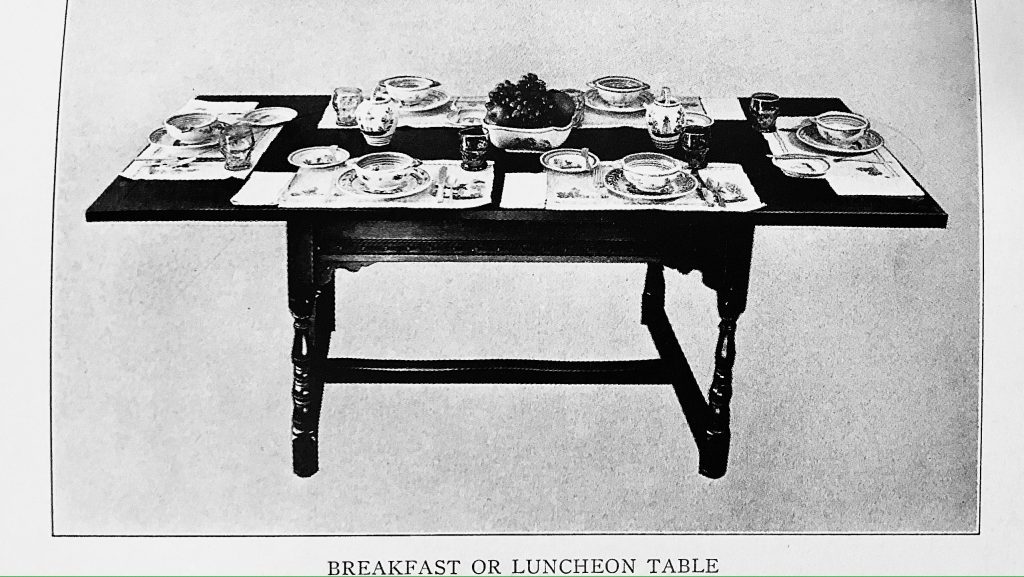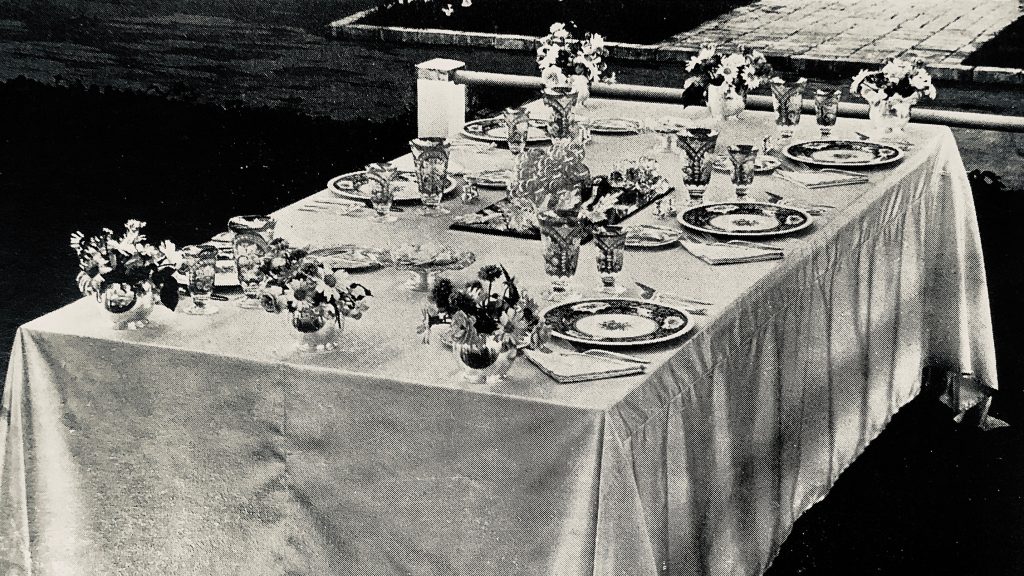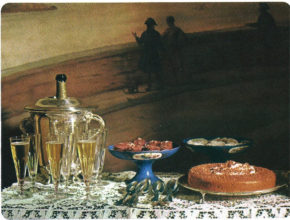I’m going to say right now that all of this is going to be a massive oversimplification. I’m not looking to go into every detail of how breakfast became the modern meal we know and I’m only considering western food at this point, and the medieval times were an astounding number of centuries, so just assume that I’m condensing a lot.
Breakfast parties really weren’t a thing until the early 19th century. Firstly, as the name implies, the earliest western breakfasts came out of early medieval times, when one broke ones fast after attending church in the morning. Prior to that the morning meal tended to be left-overs for the average plebe. Again, this is a gross oversimplification, the greeks and romans had dishes such as porridge only served at breakfast and porridge continued to be served all throughout Europe. But more often people did not distinguish breakfast as different meal from the others they would have during the day. For a modern day example of this, think of the Japanese breakfast that usually consists of rice, miso soup and a protein, usually in the form of fish.
Breakfast was generally restricted by religious edicts, but slowly, as religious rules fell into decline and cooking methods became more refined, the quality of breakfast improved for nearly everyone. Once tea became plentiful and more affordable, it moved from the being the sole property of the aristocracy, to a drink of the middle classes. With that, by the end of the 17th century, we begin to see hints of our modern breakfast.
In 18th century France, the Aristocracy ate well at breakfast, with tables groaning with everything from meat and eggs to wine and cake, even while the rest of the population survived on very little indeed. Over in Britain, it was bread, cheese and cold meats that could be found on the the early Hanovarian kings tables, but they caught up with their continental counterparts fast and by the late 1700s had their own huge, ostentatious breakfasts. In America, eggs, toast and bacon were all readily available and as popular as they are now. Though, by the end of the century, we were embroiled in the Revolutionary war, so coffee replaced tea and large breakfasts became harder to come by depending on where you were and what class you came from.
By the Regency, we see toast and butter, boiled eggs, tea, chocolate and bacon appearing at table, even among the middle classes. French breads and pastries began making an appearance too. Breakfast was now a meal seen as different from dinner. It was lighter, more refined and less formal. This really is the birth of our modern breakfast. And as soon as the breakfast was born, accounts of breakfast parties that began at 10am and went for hours began appearing. It is a truth universally told, we as a species love to party and will take any excuse to do so.
In the Victorian era, exotic spices and dishes landed on the tables of the wealthy, transported from far flung colonies. Kedgeree, which contained curry and fish appeared on British breakfast tables. More importantly, improvements in chicken farming meant that eggs were available in all seasons. Eggs, appeared on the breakfast table all year round. In America, regional and immigrants cuisines blended together with newly packaged porridges and cereals to create new breakfast traditions, leading to tables laden with items like grits, biscuits, bagels, smoked meats or sausages.
This continued in the Edwardian era, with enormous breakfasts for those who could afford it. Not only the breakfast items we would recognize like eggs and bacon were served, but one might find game meats and sweets on the table. All of these changes to the breakfast meal were reflected in The Breakfast Party. Silver on the sideboard suddenly contained Indian or regional dishes alongside the cold meats, smoked fish and eggs. Oddly, in America, the emphasis on work and an obsession with healthy living and healthy bowels led breakfast to decline in the US. A quick breakfast of toast, cereal or quick-cooking porridge with a cup of coffee being far more common. It would be several decades and an infamous ad campaign before Americans would once again embrace large breakfasts again en masse.
Breakfast parties also emulated country house parties, where the wealthy would have guests to stay at their summer or winter home. Even with extensive servants, large parties of guests meant that breakfasts were served buffet style and guest would roll in and out serving themselves. As there were extensive outdoor pursuits, breakfasts would be hearty affairs consisting of the normal breakfast dishes, but also game meats shot on the land. These breakfasts were convivial affairs where people discussed their pursuits for the day and were able to enjoy the other houseguests in an informal manner. Though these were not technically breakfast parties, (as everyone is a guest of the house and invitations are not issued) you can see the similarities. As reports of great breakfasts at country houses appeared in the papers, hosts who did not have the benefit of a great estate modeled their own breakfast parties after what they had read.
“The hour for a breakfast party may be anywhere between half-past nine and eleven o’clock. Very formal breakfasts are sometimes given at twelve, but these can be breakfast only in name in our busy country where everyone rises before ten o’clock, except singers, the theatrical profession, and literary people who prefer the night hours for their work. People who get up at the usual time must have a lunch before noon, and thus the twelve o’clock breakfast is in reality a formal luncheon.”
The Social Mirror by Rose E. Cleveland (1888)
By the Victorian period, the breakfast party seems to have codified into a fairly intimate social gathering where guests were invited for a light meal, (though remember that light by Victorian standards would be far heavier than any meal we eat today). As you can see in The Social Mirror, the Victorians allow for a breakfast party at 9:30 am, but by 1907, breakfasts that are held like a party seem to move to noon or later, as seen below.
“The breakfast – which is really a luncheon served at an earlier hour- twelve or half-past usually, is rather more informal in character, and the Sunday breakfast to which men as well as women are bidden is quite a feature of modern city life. The guest go into the dining-room in a body, at affairs of this kind, instead of entering in pairs as at dinner. The menu itself is about the same as at luncheon and served in precisely the same way. Much dressing is not considered good form at daytime functions, but at dinner a woman may make herself as resplendent as she pleases.”
Correct Social Usage by the New York Society of Self Culture, (1907)
Right off, you can see the appeal of the breakfast party over the dinner party. The informality that allows men and women to enter the room as a group indicates that the host or hostess does not pair off dining partners by rank or ulterior motive. How refreshing it must have to pile in together and form ones own pairs. How liberating.

This still leaves the question as to why, if you set the table like a luncheon, serve it just a little earlier than a luncheon and it consists of the same dishes as you’d find at a luncheon, why not just call it a luncheon? Well, luncheons were generally for women to entertain other women. A man might be invited as a guest of honor, say a poet giving a reading or a political figure who wished to appeal to the wives of his constituents, but in reality, luncheons were predominantly entertainments given by women, for women. So, what was a host to do who wanted to invite both men and women to an informal daytime party? Throw a luncheon and call it “a breakfast”.
Later Rose Cleveland recounts the pleasure of a breakfast entertainment:
“Breakfasts, given to a few congenial people, may be made very charming affairs. Lord Macaulay has said: “Dinner-parties are mere formalities; but you invite a man to breakfast because you want to see him”. Occasionally, one may be invited to the latter for the same reason that he is to dinner, to pay off an obligation, to be lionized, or on some other score; but, proportionately, as there is less formality and fewer courses than at dinner, is there more enjoyment and social interchange.”

What does one serve?
“”Fruit always forms the first course; coffee is served, at pleasure, throughout the meal, or at the close; eggs appear in some form, usually as an entree or at the close as a sweet omelet; ices and cake, except at a wedding breakfast, are not considered indispensable and are rarely served”
Practical Cooking and Serving
“Silver is laid out on the buffet or side table, with stacks of plates. Guests help themselves to a main hot dish or two set out over heaters on the buffet. Pitchers of fruit juices are set out with glasses on a silver tray. the hostess pours the coffee, and a maid or a devoted friend manages the electric toaster.”
The New American Etiquette by Lily Haworth Wallace, (1941)
I love that by 1941 the hostess has a toaster on the sideboard, but then again, I’m obsessed with everything in the 1920-1940’s toastmaster line. I dream of owning a 1920’s toaster… but I digress.
Breakfast parties seem to die out after the 40s, they are mentioned less and less in etiquette guides until they disappear around the 60’s. Possibly this has to do with the fact that more and more people worked and couldn’t fit a fancy breakfast into their schedule or maybe it’s because people overall became less formal and so dressing up for breakfast lost it’s appeal. It could be that people became just the tiniest bit less sexist and the term luncheon lost its stigma, or maybe it was the overall decline in interest in breakfast. Could it be because around this time Brunch become popular? It is likely the culmination of all of these factors and more. What I do know is except for the very formal parties associated with Hunts, Weddings and Debuts, breakfast parties became rarities.
Breakfast parties had a small revival in the 70s and 80’s, mostly as an after church get together or as alfresco garden affairs. Sadly, it was a time when cholesterol was becoming a bad word and everyone began avoiding eggs, so enticing people to come over for a bowl of bran cereal and grapefruit didn’t really hold a lasting appeal.
Now a days, we tend to go out for brunch, (I covered brunch in an earlier post) but I’m not adverse to bringing the breakfast party back. I had a small breakfast party when a group of some friends and I went out for an early morning walk at Descanso Gardens. I made a dish of Mexican eggs, had fresh fruit salad, a coffee cake and brought thermoses of coffee and hot chocolate. It was lovely. Plus no one felt guilty since we walked afterwards. I say we bring these parties back!
If you have ideas for breakfast parties, please let me know. And as always, much love to you and yours.


